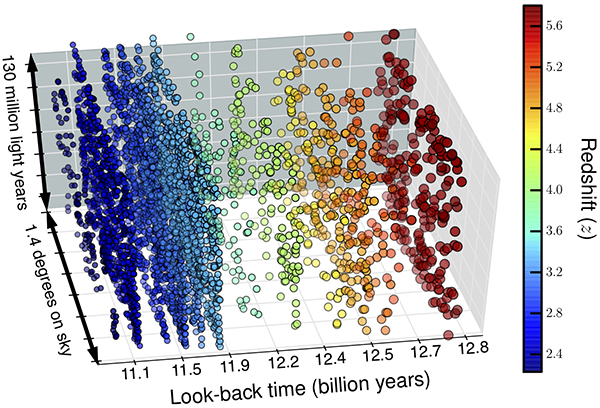ING web news release
5 April, 2018
A 3D Map of the Infant Universe
A team of astronomers led by Dr David Sobral of Lancaster University, UK made one of the largest 3D maps of the infant universe using the Subaru telescope in Hawaii and the Isaac Newton Telescope (INT).
Looking back in time to 16 different epochs between 11 and 13 billion years ago, the researchers discovered almost 4,000 early galaxies, many of which will have evolved into galaxies like our
own Milky Way.
Light from the most distant galaxies takes billions of years to reach us. This means that telescopes act as time machines, allowing astronomers to see galaxies in the distant past.
The light from these galaxies is also stretched by the expansion of the universe, increasing its wavelength to make it redder. This so-called redshift is related to the distance of the galaxy.
By measuring the redshift of a galaxy, astronomers can deduce its distance, how long its light has taken to reach us and hence how far back in time we are seeing it. In the new work the team used filters to sample particular wavelengths of light, and therefore specific epochs in the history of the universe.
|
 |
A map of the cube of spacetime covered in the new survey, showing the 'lookback time' to the galaxies in billions of years. The positions of the 4,000 galaxies appear as circles. The colours represent the degree of redshift seen, with the bluer circles indicating galaxies seen in the more recent past, and so less redshifted. Green, yellow, orange and red circles indicate successively higher redshifts, and galaxies that are progressively seen further back in time. Credit: D. Sobral. Large format: [ JPEG ].
|
The team searched for distant galaxies emitting Lyman-alpha radiation, using 16 different narrow and medium band filters over the COSMOS field, which is one of the most widely studied regions of sky outside our Milky Way, located in the direction of the constellation of Sextans.
Dr Sobral said: "The wide-field capabilities of the INT allowed us to travel back in time about 11 and 12 billion years and to significantly contribute to slicing COSMOS with 4 thousand galaxies (SC4K). One of our specially developed narrow-band filter at the INT provides us the bluest coverage, and has already allowed us to study how distant Lyman-alpha photons escape from these distant early galaxies".
He added: "These early galaxies seem to have gone through many more 'bursts' when they formed stars, instead of forming them at a relatively steady rate like our own galaxy. Additionally, they seem to have a population of young stars that is hotter, bluer and more metal-poor than those we see today."
The researchers also found that these early galaxies are incredibly compact. "The bulk of the distant galaxies we found are only about 3 thousand light-years across in size, while our Milky Way is about 30 times larger. Their compactness likely explains many of their exciting physical properties that were common in the early universe," comments Ana Paulino-Afonso, a PhD student in Lancaster and Lisbon. "Some of these galaxies should have evolved to become like our own and thus we are seeing what our galaxy may have looked like 11 to 13 billion years ago."
More information:
David Sobral, Sérgio Santos, Jorryt Matthee, Ana Paulino-Afonso, Bruno Ribeiro, João Calhau, Ali Khostovan, 2018, "Slicing COSMOS with SC4K: the evolution of typical Lyα emitters and the Lyα escape fraction from z~2 to z~6", MNRAS, in press [ ADS ].
Ana Paulino-Afonso, David Sobral, Bruno Ribeiro, Jorryt Matthee, Sérgio Santos, João Calhau, Alex Forshaw, Andrea Johnson, Joanna Merrick, Sara Pérez and Oliver Sheldon, 2018,
"On the UV compactness and morphologies of typical Lyman-alpha emitters from z~2 to z~6,", MNRAS, in press [ ADS ]
"Astrophysicists map the infant Universe in 3D and discover 4000 early galaxies", European Week of Astronomy and Space Science press release, 4th April 2018.
"Lyman-α Giant Halos Around Early Milky Way Type Galaxies", ING, web news release, 12 January 2017.
|
|



